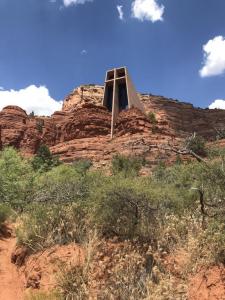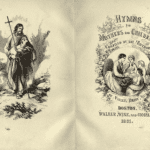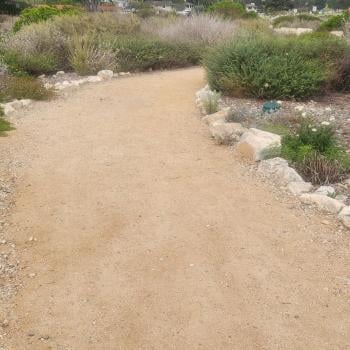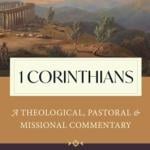Sedona, Arizona, is full of vortexes, as they call them locally, spots where the earth is supposed swirl out life-force energy. “Find out what a vortex is and how it can help you,” the town’s promotional literature invites.
My husband and I learned this when we, this summer, had time to make a day trip. One can’t help but think: what is it with us, with Americans, that the way this luxe locale gilds its lily is to promise the things of the spirit, rather than just scenery and high-end shopping?
Sedona is more than ordinarily endowed with spiritual travel sites. Among the most noteworthy is a Catholic Chapel of the Holy Cross, rising up out of the red rocks. Its story, according to National Register of Historic places, is pretty straightforward. Marguerite Brunswig Staude imagined a church building with the shape of a cross imposed on it. This ambition was impressed on her by a 1932 vision of the Empire State Building appearing to bear the sign of the cross. She collaborated with Lloyd Wright, son of Frank Lloyd Wright, and planned for a massive church in Budapest, but the Second World War intervened. Eventually Staude chose the site because she and her husband loved this part of Arizona. Because these lands fell within the Coconino National Forest, Staude required special dispensation, which she obtained through the intercession of Senator Barry Goldwater. The steel and concrete structure was completed in 1956. Staude gifted the chapel to the Catholic church, to honor her parents and the seeking of God through art.
But what a strange story this is. Staude may be commended for wanting to make a whole building in the shape of a cross, but that idea is an old familiar one in ecclesiastical architecture. Taking inspiration for a small holy building in the desert West, on ground revered by native predecessors, from a new minted New York sky scraper, is also provocative–a building named after the state’s commercial dominance earned in the early nineteenth-century when the Erie Canal made good that claim. And what might be implied by a Catholic church built so stupendously upon a rock, a fact noted in a book about Staude’s church but left unmentioned on the premises? Not that any Catholic pressure called forth the chapel in the first place. Not designed for any pre-existing community of worshiping Catholics, the chapel languished during some decades after its founding, sometimes used by Carmelite priest Father William McNamara. Late twentieth-century intervention restored it and made it attractive to tourists. Arizonans in 2007 voted it one of seven man-made wonders of their state.
No sacraments are celebrated regularly there; for that, supplicants would have to go the parish church, St. John Vianney, to which the chapel belongs. But the building is indeed prayer-inducing. Like other midcentury modern churches, this chapel illustrates architecture in an ecumenical idiom. The sculpture that rises between the viewer and the great picture windows Christ on the cross as a tree of life. It is new, offered by Protestant sculptor James Muir, who was persuaded to do the work for the Catholic chapel. This crucifix replaces one with an even more dramatic story, the so-called “Christ of the Atomic Age,” Keith Monroe’s emaciated, blackened figure that reminded viewers likened to a victim of nuclear attack. I think a case could be made for that depiction of Christ, despised and rejected and bearing sorrows we recognize, but that sculpture got mysterious disposal, reportedly being abruptly removed, hacked into segments, and left in the desert.
Staude wanted the space to be welcoming to people, writing, “Though Catholic in faith, as a work of art the Chapel has a universal appeal. Its doors will ever be open to one and all, regardless of a creed, that God may come to life in the souls of all men and be a living reality.” It stands at remove from denomination or particularity, proposing that the greatness of God—what anyone could observe from the landscape—would reveal itself to even casual visitors. It is a stunning place, mountains behind and before with big-windowed view and tall storied crucifix in front. It feels like the kind of place people, even people only there to check off a Tripadvisor top ten, might feel led to pray.
What do we go out to the desert to see? The casual visitor may approach both chapel and vortex in approximately the same way: that maybe there’s something to this, maybe something might happen. Particularly in our time, Staude’s “open to one and all” approach might be most right, the face of Christ looking down at passers through who look up to the mountains. I think the chapel is more welcoming than a healing vortex. I did not visit any designated vortexes (the tourist literature resists using what I understand as the conventional plural, vortices) because I suppose I don’t really believe in them. Whether special energies, or the spirit of God, inhabit particular places or suffuse the whole of the gorgeous and everyday creation, aflame but not consumed, is a good theological argument. A chapel dominated inside and outside by the tree of life, in landscape mercilessly reminding of the scope of geologic time and the littleness of human life spans—that might allow for some healing .
.













